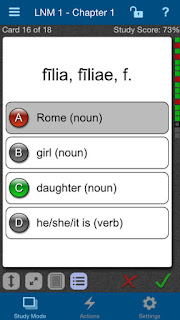The 2015–2016
Roman Calendar has arrived! In the newly redesigned calendar, you will find
full-color images featuring the Olympian gods alongside the ever-popular sententiae. The calendar also contains
information about our latest
books, longtime favorites, apps, and more. Check the inside back cover for
a reproducible worksheet that asks students to engage with the artwork included
in the calendar.
For those completing the worksheet, here is September's image, question, and answer.
Question:
In this scene, Vulcan presents arms to Venus. For whom are they intended? In what literary work is this story told? How many weapons and types of armor can you identify?
Answer:
Francesco Solimena’s Venus at the Forge of Vulcan is based on a scene from the Aeneid (8.370–449, 608–25) in which Venus asks Vulcan to make new weapons for Aeneas. Solimena’s painting depicts a helmet, a sword, a shield (described at length in Aeneid 8.626–731), a breastplate, and an axe.
 |
| Francesco Solimena's Venus at the Forge of Vulcan. |
Question:
In this scene, Vulcan presents arms to Venus. For whom are they intended? In what literary work is this story told? How many weapons and types of armor can you identify?
Answer:
Francesco Solimena’s Venus at the Forge of Vulcan is based on a scene from the Aeneid (8.370–449, 608–25) in which Venus asks Vulcan to make new weapons for Aeneas. Solimena’s painting depicts a helmet, a sword, a shield (described at length in Aeneid 8.626–731), a breastplate, and an axe.
To add your name to our mailing list for the Roman Calendar, email orders@bolchazy.com with the subject line “Roman Calendar”; be sure to include your name and mailing address in the body of the email. Also, let us know by email if you have not received your calendar yet!




